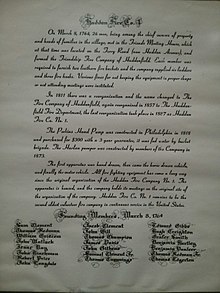User:Foxmilder/sandbox
Ancient Rome[edit]
The earliest known firefighting service was formed in Ancient Rome by Marcus Egnatius Rufus who used his slaves to provide a free fire service.[1] These men fought fires using bucket chains and also patrolled the streets with the authority to impose corporal punishment upon those who violated fire-prevention codes. The Emperor Augustus established a public fire department in 24 BCE, composed of 600 slaves distributed amongst seven fire stations in Rome.[2]
1600s and 1700s[edit]
Fire departments were again formed by property insurance companies beginning in the 17th century after the Great Fire of London in 1666. The first insurance brigades were established the following year.[3] Others began to realize that a lot of money could be made from this practice, and ten more insurance companies set up in London before 1832: The Alliance, Atlas, Globe, Imperial, London, Protector, Royal Exchange, Sun Union and Westminster.[4] Each company had its own fire mark, a durable plaque that would be affixed to the building exterior. Although a popular legend says a company's fire brigade would not extinguish a burning building if it did not have the correct fire mark, there is little evidence to support this; evidence shows insurance companies required their firefighters to fight every fire they encountered.[5]
Amsterdam also had a sophisticated firefighting system in the late 17th century, under the direction of artist Jan van der Heyden, who had improved the designs of both fire hoses and fire pumps.[6]
The city of Boston, Massachusetts established America's first publicly funded, paid fire department in 1678.[7][8][9]
Fire insurance made its debut in the American colonies in South Carolina in 1736, but it was Benjamin Franklin who imported the London model of insurance. He established the colonies' first fire insurance company in Philadelphia named the Philadelphia Contributionship,[3] as well as its associated Union Volunteer Fire Company, which was an unpaid (volunteer) company.[10]
A document dated in 1686 informs about the payment system of four so called "fire servants" (German: Feuerknecht) in Vienna, which is the official founding year of the Vienna Fire Department.
In 1754,[11] Halifax, Nova Scotia established the Halifax Regional Fire and Emergency, which is today Canada's oldest fire department.

In 1764, Haddonfield, New Jersey established the second oldest fire company in the United States.
In 1773, the city of Petersburg, Virginia established one of the first fire departments in the United States[12][13] and it was also made up of unpaid volunteers[14]
1800s[edit]
In the 19th century, the practice of fire brigades refusing to put out fires in buildings that were uninsured led to the demand of central command for fire companies.[15] Cities began to form their own fire departments as a civil service to the public, obliging private fire companies to shut down, many merging their fire stations into the city's fire department. In 1833, London's ten independent brigades all merged to form the London Fire Engine Establishment (LFEE), with James Braidwood as the Chief Officer.[16] Braidwood had previously been the fire chief in Edinburgh, where the world's first municipal fire service was founded in 1824, and he is now regarded, along with Van der Heyden, as one of founders of modern firefighting.[6] The LFEE then was incorporated into the city's Metropolitan Fire Brigade in 1865 under Eyre Massey Shaw.
In 1879, the University of Notre Dame established the first University-based fire department in the United States[17]
1900s[edit]
In 1906, the first motorized fire department was organized in Springfield, Massachusetts, after Knox Automobile of Springfield
- ^ "Fire-brigades in the Roman realm". Economypoint.org. Retrieved 3 July 2010.
- ^ Coe, Charles K. (February 2009). Handbook of Urban Services: A Basic Guide for Local Governments. M.E. Sharpe. p. 29. ISBN 978-0-7656-2294-5.
- ^ a b Cote, Arthur E.; Bugbee, Percy (December 1988). Principles of fire protection. Jones & Bartlett Learning. p. 6. ISBN 978-0-87765-345-5. Retrieved 4 October 2011.
- ^ "From Fire Marks to James Braidwood, the Surveyor who set up the Fire Brigade". Independent Surveyors Association. Retrieved 4 October 2011.
- ^ "Early insurance brigades". London Fire Brigade. Archived from the original on 20 December 2022. Retrieved 21 December 2022.
- ^ a b Hensler, Bruce (2011). Crucible of Fire: Nineteenth-Century Urban Fires and the Making of the Modern Fire Service. Potomac Books, Inc. pp. 1–2. ISBN 978-1-59797-684-8.
- ^ Klinoff, Robert (2007). "Public Fire Protection". Introduction to Fire Protection, 3rd Edition. Thomson Delmar Learning. p. 59. ISBN 978-1-4180-0177-3.
- ^ "History - City of Boston". February 2016.
- ^ "Boston History Before 1859". Boston Fire Historical Society. Retrieved 2023-06-09.
- ^ IFSTA (2004). Fire Service Orientation and Terminology. Fire Protection Publications, University of Oklahoma. ISBN 978-0-87939-232-1.
- ^ "Museum shows off Canada's oldest fire department's history". The Chronicle Herald.
- ^ ""Established in 1773, the Petersburg Department of Fire, Rescue, and Emergency Services is one of the oldest organized fire departments in the country"". Archived from the original on 28 June 2017. Retrieved 14 October 2015.
- ^ "Petersburg, VA - Official Website - Fire, Rescue, and Emergency Services".
- ^ "Petersburg, VA - Official Website - Fire Department History".
- ^ Anderson, Annelise. "The Development of Municipal Fire Departments in the United States" (PDF). Mises Institute. Retrieved 28 February 2018.
- ^ "James Braidwood and the London Fire Engine Establishment (LFEE)". London Fire Brigade. Archived from the original on 3 September 2011. Retrieved 4 October 2011.
- ^ ENR/PAZ // University Communications: Web // University of Notre Dame. "NDFD, nation's oldest university fire department, turns 135".

